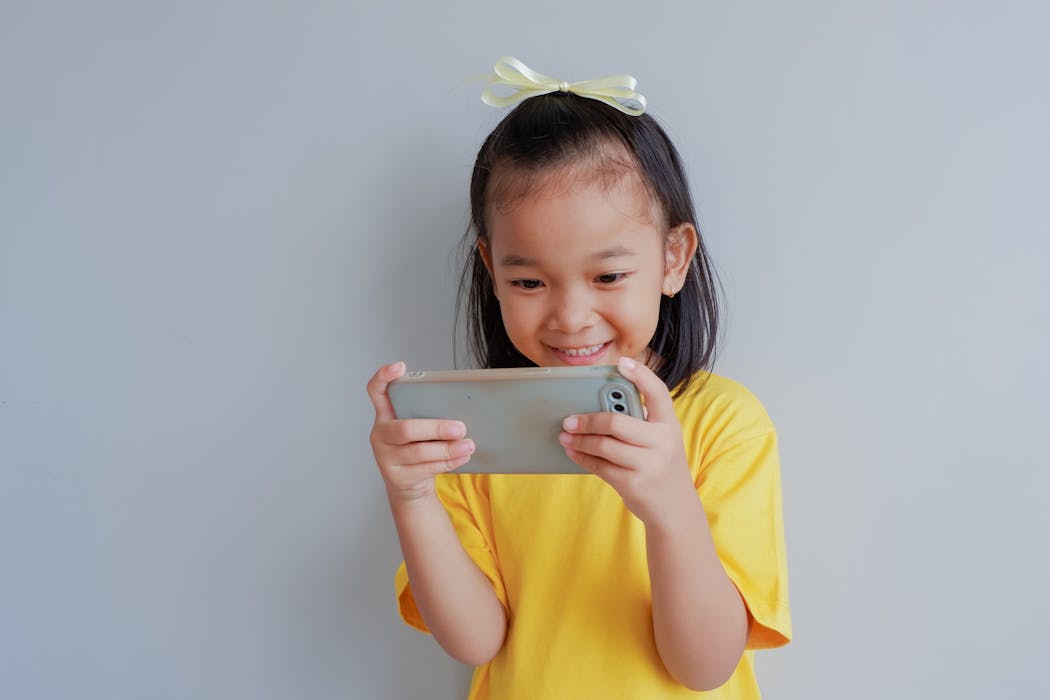- Home
Edition
Africa Australia Brasil Canada Canada (français) España Europe France Global Indonesia New Zealand United Kingdom United States Edition:
Global
Edition:
Global
- Africa
- Australia
- Brasil
- Canada
- Canada (français)
- España
- Europe
- France
- Indonesia
- New Zealand
- United Kingdom
- United States
 Academic rigour, journalistic flair
Academic rigour, journalistic flair
 arthierry/Shutterestock
How technology is reshaping children’s development – the good, the bad and the unknown
Published: November 24, 2025 1.43pm GMT
Valentina Fantasia, Lund University, Joanna Rączaszek-Leonardi, University of Warsaw
arthierry/Shutterestock
How technology is reshaping children’s development – the good, the bad and the unknown
Published: November 24, 2025 1.43pm GMT
Valentina Fantasia, Lund University, Joanna Rączaszek-Leonardi, University of Warsaw
Authors
-
 Valentina Fantasia
Valentina Fantasia
Associate Professor of Cognitive Science, Lund University
-
 Joanna Rączaszek-Leonardi
Joanna Rączaszek-Leonardi
Professor of Psychology, University of Warsaw
Disclosure statement
Valentina Fantasia receives funding from The Wallenberg AI, Autonomous Systems and Software Program – Humanity and Society (WASP-HS). She is affiliated with the Department of Philosophy and Cognitive Science at Lund University, Sweden.
Joanna Rączaszek-Leonardi is a professor at the University of Warsaw. Her research was funded by the Polish-German collaborative research Beethoven on "Early Semantic Development" and EU H2020 Twinning project "Towards Human-centered Technology Development."
Partners
Lund University provides funding as a member of The Conversation UK.
View all partners
DOI
https://doi.org/10.64628/AB.xsmcskcr3
https://theconversation.com/how-technology-is-reshaping-childrens-development-the-good-the-bad-and-the-unknown-268148 https://theconversation.com/how-technology-is-reshaping-childrens-development-the-good-the-bad-and-the-unknown-268148 Link copied Share articleShare article
Copy link Email Bluesky Facebook WhatsApp Messenger LinkedIn X (Twitter)Print article
It’s a common scene on public transport. A parent holds a mobile phone showing noisy cartoons to their young child. The pair is looking at the screen together, laughing. Yet parent and child rarely exchange a gaze or look out across the landscape.
While many parents can relate to such moments, this is just an example of how technology (mainly digital screens but also vocal assistants, domestic robots and so on) have become part of our daily routines, changing the way we interact and engage with the world around and – most importantly – with each other.
But how does all this change how young children develop?
Human development is essentially a social practice. From infancy, we participate in the world around us and learn from experience, especially from unfamiliar situations and cultural encounters, with the help of more knowledgeable partners.
As adults interact with kids, they share views and create new knowledge. We make sense of the world around us, in its variety, complexity and beauty. Children learn from it, and adults learn how to see the world from the child’s eyes. How can we possibly encounter the world or make sense of it when our attention is captured by a screen?
Five decades of research in developmental disciplines have shown just how much human development is dependent on the fine-grained details of daily social communication. For infants and young children, communicating is not an abstract or conceptual thing: it’s based on the small, routine moments shared with others, from stopping to observe a slow-paced slug on the way to school to reading a book together at the breakfast table. This is how we become humans.
What makes those early activities between children and adults special is the fact that they are co-constructed moment by moment through talk, gaze, gestures (such as pointing to something) and movements.
As our research has extensively shown, in the first months and years of life, infants experience and learn the patterns of interaction with others, in which the timings of gaze, movements, vocalisations and language are crucial.
This includes how long you look at each other, or learn to make pauses and take turns in a conversation or activity. It’s also about making eye contact before pointing to an interesting object in the room. These patterns teach us how to relate to others and participate in joint activities, and there is currently no substitute for such learning.
Becoming post-digital humans
Smart devices and streaming tools have made digital media become an integral part of family life. Two-thirds of children aged two to five use screens for more than an hour a day, and the average starting age of screen use is getting dramatically lower.
During the past two decades, researchers have showed how digital technologies are changing the way children cope with everyday tasks and activities, from playing and paying attention to remembering things and sleeping.
Exposure to digital devices on a daily basis has been linked to difficulties with completing homework, finishing tasks and staying calm when issues arise in the family. Sleep quality also seems negatively affected by screens, particularly if it’s right before bedtime.
Even having a TV on in the background can negatively influence very young children’s play time, disturbing the quality of their focused attention and shortening their play activity.
But although neuroscience is telling us that recurrent exposure to smart technologies is already rewiring humans’ brains, not all of it is negative. High-quality media content, offered for instance by cartoons or educational apps, may help children cope better with their emotions and improve language skills.
So are we evolving into techno-hybrid super-intelligent creatures? As we let kids roam free on Sesame Street on our smartphones, are they becoming smarter?
Maybe it is not a completely negative thing after all, as writers and academics such as Jeannette Winterson and Katherine N. Hayles suggest. Becoming post-human, in their view, is the next step in humans natural evolution towards adapting and transforming into something different – not better, not worse.
Ultimately, while there is potential for technology to make children smarter in some domains, we also know it can disrupt their attention, play and sleep. What we don’t know is exactly how it impacts how children and parents relate to each other. Our group, SITE, at the Robotic lab at Lund University, is currently investigating how children understand technology and how digital practices shape interactions in early school and family.
No magic recipe
A century ago, Maria Montessori suggested that attention is the finest gift an adult can give to a child. Attention, in her view, was the capacity to attend to a child’s way of discovering the world, and then share it together.
When adults and children’s attention is oriented towards something else, detached from its context, like watching a video on the phone while sitting in a park, there might be missing opportunity to discover and learn together through moments of mutual attention.
 Attention is crucial.
Valentina Fantasia, CC BY-SA
Attention is crucial.
Valentina Fantasia, CC BY-SA
It is there that children test their agency and influence, and learn to engage and disengage with others. As technology is advancing faster than ever, we need to gauge how much technology is changing this vital contact.
Western parents are increasingly concerned over their kids’ screen time and for most, negotiating this time is a real struggle. But instead of blaming family practices, we should support parents in understanding that no magic recipe exists. The key is to find out which shared moments are best out-sourced to tech devices and which should be preserved as tech-free.
And this is our suggestion: any moment of the day spent together without screens is precious, even the ones which seem irrelevant. Reading a book at bedtime, telling invented stories while driving the car, picking up chestnuts on the street on the way home or even being bored together are all crucial.
Keep those moments and choose which ones may just be worth screens, for example when the adult’s energy is simply too low to offer anything better. No size fits everyone – just find what works for your own family.
In a few years, we might see that our slow-pace process of learning with and through others has profoundly changed. And while technology itself should not be seen as all bad or good, a deeper understanding of how children are watching, playing and doing things with digital tools is necessary.
- Child development
- Technology
- Screen time
- Give me perspective
Events
Jobs
-
 Analyst, Student Information and Regulatory Reporting
Analyst, Student Information and Regulatory Reporting
-
 Lecturer in Paramedicine
Lecturer in Paramedicine
-
 Associate Lecturer, Social Work
Associate Lecturer, Social Work
-
 Lecturer, Communication Design
Lecturer, Communication Design
-
 Leading Research Centre Coordinator
Leading Research Centre Coordinator
- Editorial Policies
- Community standards
- Republishing guidelines
- Analytics
- Our feeds
- Get newsletter
- Who we are
- Our charter
- Our team
- Partners and funders
- Resource for media
- Contact us
-
-
-
-
Copyright © 2010–2025, The Conversation

 Analyst, Student Information and Regulatory Reporting
Analyst, Student Information and Regulatory Reporting
 Lecturer in Paramedicine
Lecturer in Paramedicine
 Associate Lecturer, Social Work
Associate Lecturer, Social Work
 Lecturer, Communication Design
Lecturer, Communication Design
 Leading Research Centre Coordinator
Leading Research Centre Coordinator


